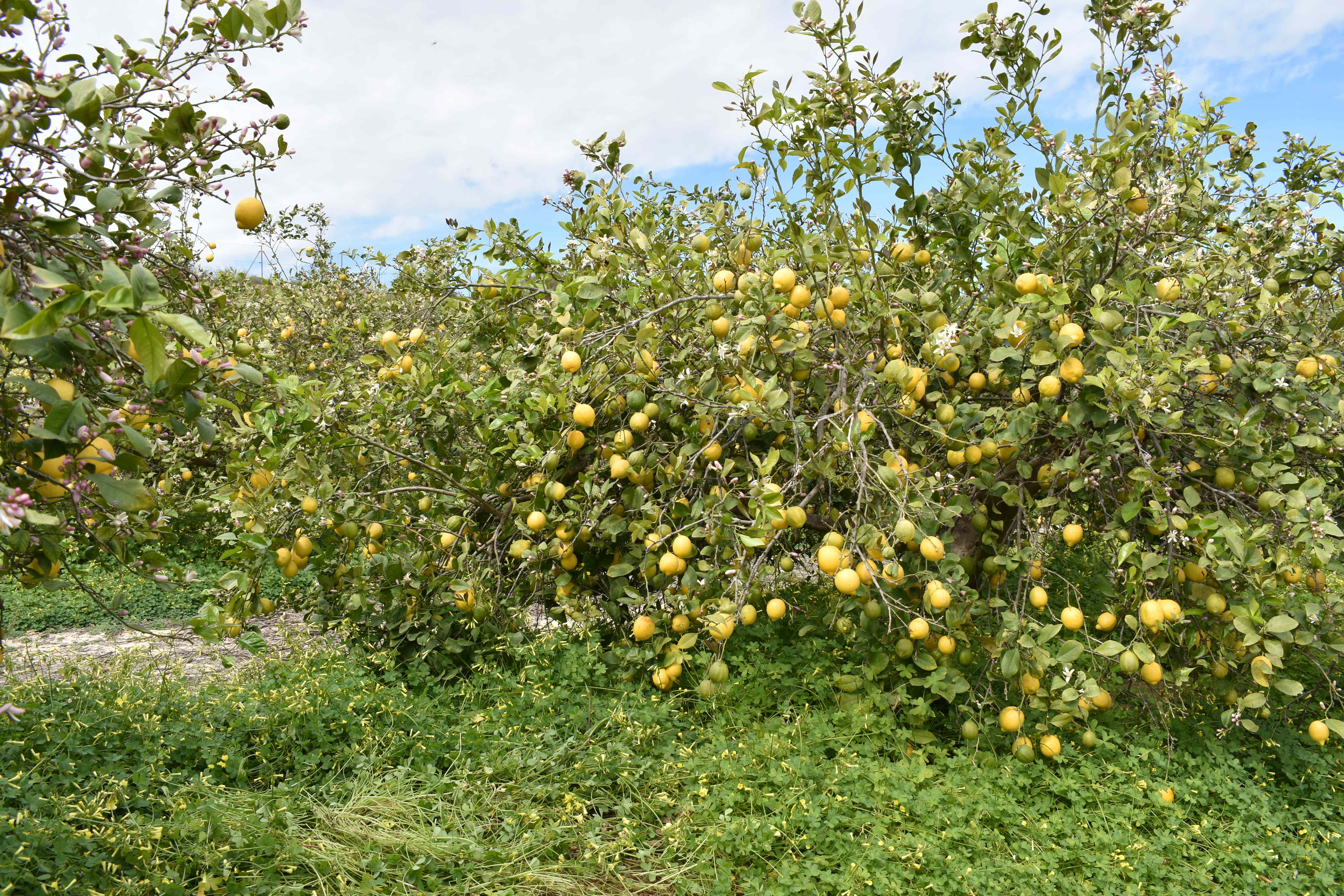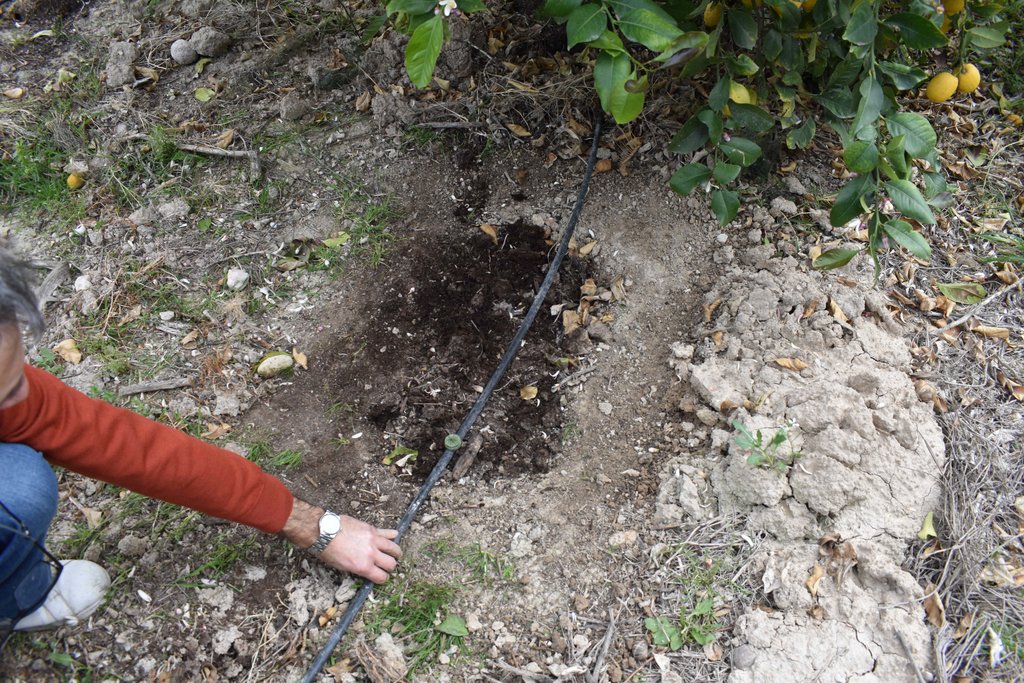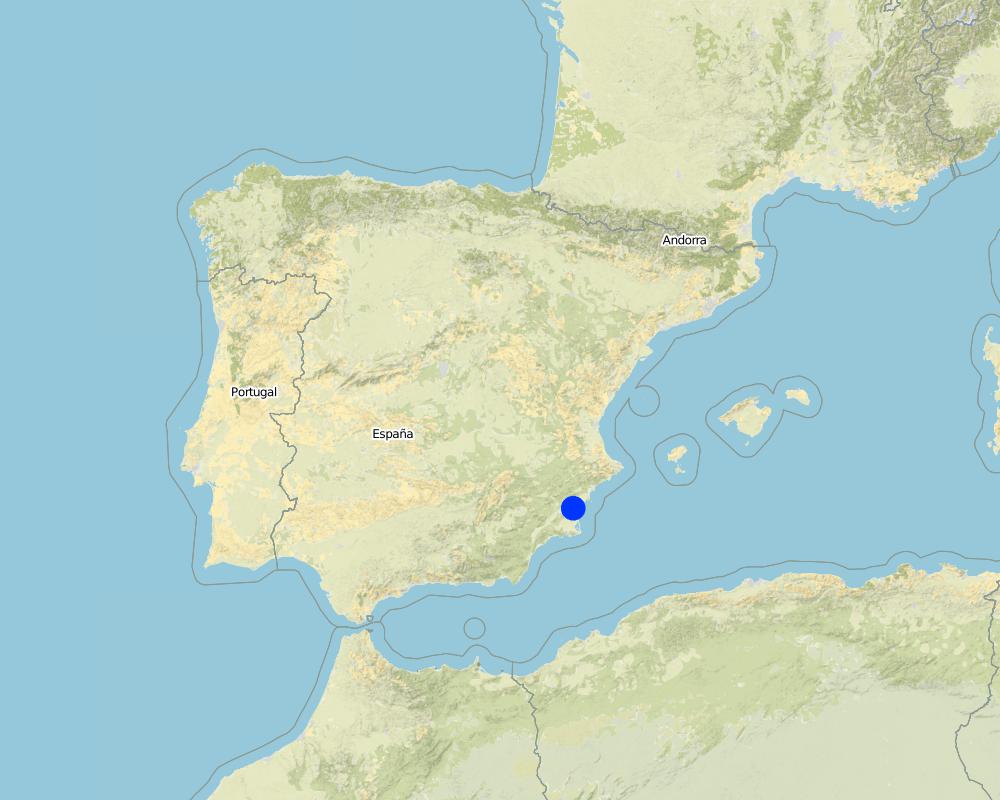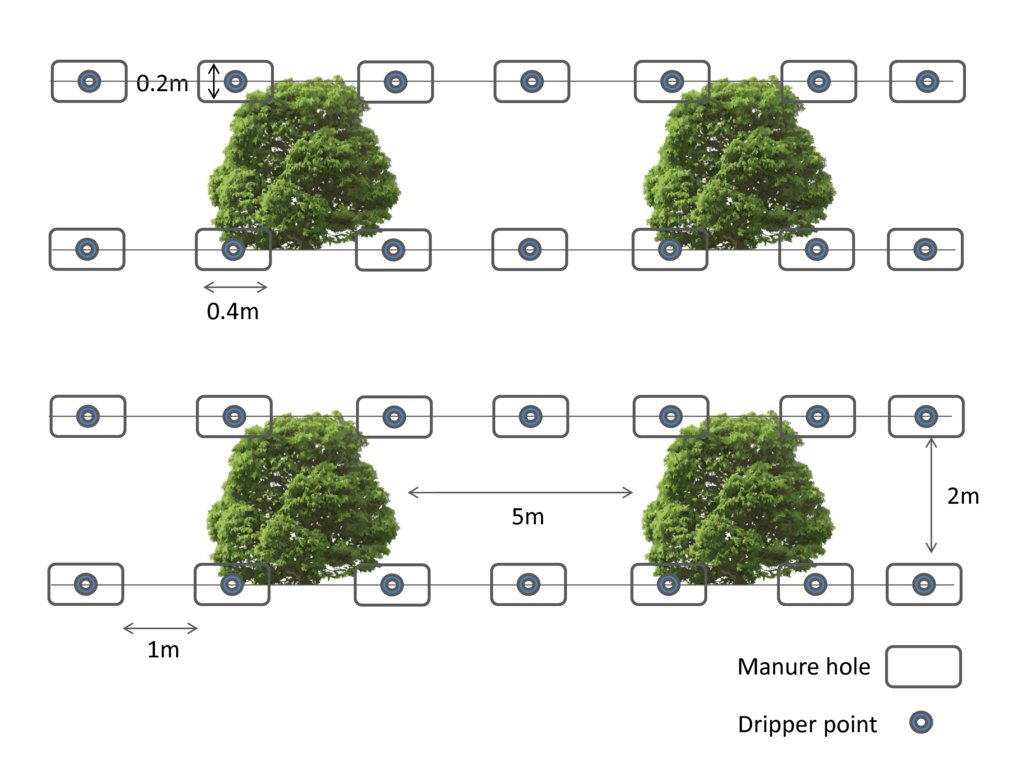Organic amendment located in dripper point in organic citrus production [Spain]
- Creation:
- Update:
- Compiler: Alicia Morugán-Coronado
- Editor: –
- Reviewers: Ursula Gaemperli, Gudrun Schwilch, Alexandra Gavilano
Aplicación de estiércol de oveja en puntos de riego por goteo en la producción de cítricos orgánicos
technologies_2010 - Spain
View sections
Expand all Collapse all1. General information
1.2 Contact details of resource persons and institutions involved in the assessment and documentation of the Technology
Name of project which facilitated the documentation/ evaluation of the Technology (if relevant)
Interactive Soil Quality assessment in Europe and China for Agricultural productivity and Environmental Resilience (EU-iSQAPER)Name of the institution(s) which facilitated the documentation/ evaluation of the Technology (if relevant)
Agrochesmistry and Environment Department, University Miguel Hernandez (UMH) - Spain1.3 Conditions regarding the use of data documented through WOCAT
The compiler and key resource person(s) accept the conditions regarding the use of data documented through WOCAT:
Ja
1.4 Declaration on sustainability of the described Technology
Is the Technology described here problematic with regard to land degradation, so that it cannot be declared a sustainable land management technology?
Nee
2. Description of the SLM Technology
2.1 Short description of the Technology
Definition of the Technology:
The land user applies organic amendment located in a dripper point. Sheep manure is applied every year in holes under the foot of every lemon tree. The holes are dug with a shovel.
2.2 Detailed description of the Technology
Description:
Natural / human environment: This SLM technology was established in land under sustainable agricultural in the region of the Vega Baja del Segura (Spain). The region under study is the most southerly county within the Valencian Community (Comunidad Valenciana). Our study site focuses on the province of Alicante. The county is Vega Baja del Segura, which has a total area of 957.73 km2. The county of Vega Baja de Segura covers the region from Orihuela to the mouth of the Segura, where it meets the Mediterranean Sea in Guardamar del Segura (Alicante). Agricultural production in this county is of a very high quality and is intensely competitive. Despite this, the region’s traditional agriculture industry is nonetheless being overtaken by other sectors, with the scarcity of water emerging as a key factor in this shift. Currently, 67% of the arable area relies on irrigation systems. In this area, small holdings yield the majority of the agricultural production: 76% of agricultural estates cover less than five hectares. The main cultivation, in terms of area, is in trees (22,900 ha). Citrus trees (lemon, orange, and mandarin) are the main trees grown in the area (INE, 2009).
Purpose of the Technology: Initially, the main objective of the land user applying the technology was to improve the soils and crop production in his fields by promoting sustainable agricultural management in the Vega Baja region. The previous use of land was conventional with inorganic fertilization and intensive ploughing. The land user had to convert the conventional lemon tree orchard to organic farming with more sustainable practices. The initial investment was very high and he needed nearly 7 years to get certified in Eco-certification and labelling by the Comité de Agricultura Ecológica de la Comunidad Valenciana.
The land user makes all kind of innovative practices to improve soil fertility and crop production; the most pioneering initiative was to apply organic amendment located in dripper points. Organic certified sheep manure is applied every year in September in holes under the foot of every lemon tree. The following year, the position of the hole is moved around the tree. The holes are dug with a shovel; each hole is 0.4 m wide and 0.2 m deep. The eco-certificate sheep manure is bought from sheep holders. The sheep manure is composed of NPK (2.9; 1.8; 2.4%) with a C/N ratio of 8.8. The organic matter content is 44.5% and the moisture value is 53.8%. The irrigation is by drippers and it includes fertilizers in it. The land user is controlling the fertirrigation dose, changing the amount depending on the nutritional state of the orchard and climatological conditions. As part of the organic agriculture, the weed is not removed anymore. Pest control is done by biological methods: fly adhesive traps, pheromones moths traps, Bacillus thuringiensis solution sprayed, paraffin oil and copper sulphate applied by drip irrigation. The pruning remains are kept on the soil surface as a mulching.
The major benefit is an enhancement of the soil organic content in the long term. There is also an improvement of the orchard productivity. The lemon trees become less prone to diseases and pests. The major disadvantage is the high costs at the beginning to change from conventional to organic and to get the Eco-certificate.
2.3 Photos of the Technology
2.4 Videos of the Technology
Comments, short description:
The organic amendment application is located in dripper points. Sheep manure was applied in holes near to the lemon trees. This technology was established in sustainable agricultural soil in the region of the Vega Baja del Segura.
Date:
23/03/2017
Location:
Orihuela (Spain)
Name of videographer:
Alicia MC
2.5 Country/ region/ locations where the Technology has been applied and which are covered by this assessment
Country:
Spain
Region/ State/ Province:
Vega Baja/Alicante
Further specification of location:
Orihuela
Specify the spread of the Technology:
- applied at specific points/ concentrated on a small area
Map
×2.6 Date of implementation
Indicate year of implementation:
2014
2.7 Introduction of the Technology
Specify how the Technology was introduced:
- through land users' innovation
3. Classification of the SLM Technology
3.1 Main purpose(s) of the Technology
- improve production
- reduce, prevent, restore land degradation
- conserve ecosystem
- preserve/ improve biodiversity
- create beneficial economic impact
- create beneficial social impact
3.2 Current land use type(s) where the Technology is applied

Cropland
- Tree and shrub cropping
Tree and shrub cropping - Specify crops:
- citrus
Number of growing seasons per year:
- 1
Specify:
The lemon is harvested between February and March
3.4 Water supply
Water supply for the land on which the Technology is applied:
- full irrigation
3.5 SLM group to which the Technology belongs
- integrated soil fertility management
3.6 SLM measures comprising the Technology

agronomic measures
- A2: Organic matter/ soil fertility
3.7 Main types of land degradation addressed by the Technology

chemical soil deterioration
- Cn: fertility decline and reduced organic matter content (not caused by erosion)

physical soil deterioration
- Pc: compaction
- Pk: slaking and crusting

biological degradation
- Bq: quantity/ biomass decline
- Bl: loss of soil life
3.8 Prevention, reduction, or restoration of land degradation
Specify the goal of the Technology with regard to land degradation:
- prevent land degradation
- reduce land degradation
4. Technical specifications, implementation activities, inputs, and costs
4.1 Technical drawing of the Technology
Technical specifications (related to technical drawing):
Species used: Lemon tree (Citrus verna)
Lemon tree root depth: 0.5-0.6m
Spacing between plants: 5m
Spacing between manure holes: 1m
Vertical intervals between drip irrigation rows: 2m
Width holes: 0.2m
Lengths holes: 0.4m
Depths holes: 0.2m
Author:
Alicia Morugán Coronado
Date:
24/03/2017
4.2 General information regarding the calculation of inputs and costs
Specify how costs and inputs were calculated:
- per Technology area
Indicate size and area unit:
7.7 ha
other/ national currency (specify):
Euro
If relevant, indicate exchange rate from USD to local currency (e.g. 1 USD = 79.9 Brazilian Real): 1 USD =:
0.944508
Indicate average wage cost of hired labour per day:
60
4.5 Maintenance/ recurrent activities
| Activity | Timing/ frequency | |
|---|---|---|
| 1. | Digging hole | September |
| 2. | Organic amendment | September |
| 3. | Irrigation | all year |
| 4. | Biological control | all year |
| 5. | Fertirrigation | All year, except autumn and winter |
| 6. | Pruning material left on soil surface | May, July and August |
4.6 Costs and inputs needed for maintenance/ recurrent activities (per year)
| Specify input | Unit | Quantity | Costs per Unit | Total costs per input | % of costs borne by land users | |
|---|---|---|---|---|---|---|
| Labour | Organic amendment | person/hour | 5.0 | 6.0 | 30.0 | 100.0 |
| Labour | Pruning | person/hour | 100.0 | 6.0 | 600.0 | 100.0 |
| Labour | Fertirrigation | person/hour | 100.0 | 6.0 | 600.0 | 100.0 |
| Labour | Biological control | person/hour | 30.0 | 10.0 | 300.0 | 100.0 |
| Equipment | Tractor with trailer (hire per day) | piece | 2.0 | 30.0 | 60.0 | 100.0 |
| Fertilizers and biocides | Organic amendment | kg | 1200.0 | 30.0 | 36000.0 | 100.0 |
| Fertilizers and biocides | Fertirrigation | Litres | 1400.0 | 8.0 | 11200.0 | 100.0 |
| Fertilizers and biocides | Bacillus thuringiensis | Kg | 60.0 | 20.0 | 1200.0 | 100.0 |
| Fertilizers and biocides | Copper sulphate solution | Kg | 5.0 | 30.0 | 150.0 | 100.0 |
| Fertilizers and biocides | Paraffin oil | Litres | 10.0 | 30.0 | 300.0 | 100.0 |
| Fertilizers and biocides | Adhesive trap | piece | 100.0 | 10.0 | 1000.0 | 100.0 |
| Fertilizers and biocides | Pheromone trap | piece | 10.0 | 40.0 | 400.0 | 100.0 |
| Total costs for maintenance of the Technology | 51840.0 | |||||
| Total costs for maintenance of the Technology in USD | 54885.72 | |||||
Comments:
The price of sheep manure is so high because he has to buy it from eco-certified sheep holders.
4.7 Most important factors affecting the costs
Describe the most determinate factors affecting the costs:
The pests, and the loss of product caused by unexpected weather.
5. Natural and human environment
5.1 Climate
Annual rainfall
- < 250 mm
- 251-500 mm
- 501-750 mm
- 751-1,000 mm
- 1,001-1,500 mm
- 1,501-2,000 mm
- 2,001-3,000 mm
- 3,001-4,000 mm
- > 4,000 mm
Specify average annual rainfall (if known), in mm:
250.00
Agro-climatic zone
- semi-arid
5.2 Topography
Slopes on average:
- flat (0-2%)
- gentle (3-5%)
- moderate (6-10%)
- rolling (11-15%)
- hilly (16-30%)
- steep (31-60%)
- very steep (>60%)
Landforms:
- plateau/plains
- ridges
- mountain slopes
- hill slopes
- footslopes
- valley floors
Altitudinal zone:
- 0-100 m a.s.l.
- 101-500 m a.s.l.
- 501-1,000 m a.s.l.
- 1,001-1,500 m a.s.l.
- 1,501-2,000 m a.s.l.
- 2,001-2,500 m a.s.l.
- 2,501-3,000 m a.s.l.
- 3,001-4,000 m a.s.l.
- > 4,000 m a.s.l.
Indicate if the Technology is specifically applied in:
- not relevant
5.3 Soils
Soil depth on average:
- very shallow (0-20 cm)
- shallow (21-50 cm)
- moderately deep (51-80 cm)
- deep (81-120 cm)
- very deep (> 120 cm)
Soil texture (topsoil):
- medium (loamy, silty)
Soil texture (> 20 cm below surface):
- medium (loamy, silty)
Topsoil organic matter:
- medium (1-3%)
5.4 Water availability and quality
Ground water table:
on surface
Availability of surface water:
medium
Water quality (untreated):
for agricultural use only (irrigation)
Is water salinity a problem?
Nee
Is flooding of the area occurring?
Nee
5.5 Biodiversity
Species diversity:
- high
Habitat diversity:
- medium
5.6 Characteristics of land users applying the Technology
Sedentary or nomadic:
- Sedentary
Market orientation of production system:
- commercial/ market
Off-farm income:
- > 50% of all income
Relative level of wealth:
- poor
Individuals or groups:
- individual/ household
Level of mechanization:
- manual work
- mechanized/ motorized
Gender:
- men
Age of land users:
- middle-aged
5.7 Average area of land used by land users applying the Technology
- < 0.5 ha
- 0.5-1 ha
- 1-2 ha
- 2-5 ha
- 5-15 ha
- 15-50 ha
- 50-100 ha
- 100-500 ha
- 500-1,000 ha
- 1,000-10,000 ha
- > 10,000 ha
Is this considered small-, medium- or large-scale (referring to local context)?
- medium-scale
5.8 Land ownership, land use rights, and water use rights
Land ownership:
- individual, not titled
Land use rights:
- leased
Water use rights:
- communal (organized)
5.9 Access to services and infrastructure
health:
- poor
- moderate
- good
education:
- poor
- moderate
- good
technical assistance:
- poor
- moderate
- good
employment (e.g. off-farm):
- poor
- moderate
- good
markets:
- poor
- moderate
- good
energy:
- poor
- moderate
- good
roads and transport:
- poor
- moderate
- good
drinking water and sanitation:
- poor
- moderate
- good
financial services:
- poor
- moderate
- good
6. Impacts and concluding statements
6.1 On-site impacts the Technology has shown
Socio-economic impacts
Production
crop production
Comments/ specify:
The land user observe that the crop production increased two times with the organic agriculture management.
crop quality
Comments/ specify:
The lemon fruit with the organic farming management is bigger than before with conventional management.
Water availability and quality
irrigation water availability
Comments/ specify:
Changing the irrigation to drip irrigation the land user can save water.
Income and costs
expenses on agricultural inputs
Comments/ specify:
Less use of fertilizer, less tillage, no herbicides/pesticides.
farm income
Comments/ specify:
The price of eco-certified lemon in the market is 3 times higher than conventional and the expenses on agricultural inputs are lower.
workload
Comments/ specify:
Only work for digging the hole, maintaining fertirrigation, harvesting and pruning, but no work for applying pesticides, tillage and weeding.
Socio-cultural impacts
health situation
Comments/ specify:
Improved health due to non-application of herbicides/pesticides.
land use/ water rights
Comments/ specify:
The farmer can buy more land due to this income.
community institutions
Comments/ specify:
Due to this eco-management, the farmer became well-known and recognized in the region. He appears in television and teaches other farmers and became the president of the regional farmer association.
SLM/ land degradation knowledge
Comments/ specify:
The farmer learned a lot about the soil and enhanced his continued education.
Ecological impacts
Water cycle/ runoff
water quantity
Comments/ specify:
Less water is used through drip irrigation.
surface runoff
Comments/ specify:
Better infiltration due to better soil structure due to the manure application, thus less runoff.
Soil
soil compaction
Comments/ specify:
Less soil compaction due to better soil structure due to the manure application.
nutrient cycling/ recharge
Comments/ specify:
Adding sheep manure increases nutrients.
soil organic matter/ below ground C
Comments/ specify:
Adding sheep manure increases organic matter.
Biodiversity: vegetation, animals
beneficial species
Comments/ specify:
The organic farming enforces the lemon trees against pests and diseases.
pest/ disease control
Comments/ specify:
The organic farming enforces the lemon trees against pests and diseases.
Climate and disaster risk reduction
flood impacts
Comments/ specify:
Flood impacts is less due to better soil structure.
landslides/ debris flows
Comments/ specify:
Land movements decrease due to better soil structure.
drought impacts
Comments/ specify:
Drought impacts decrease due to more soil moisture.
emission of carbon and greenhouse gases
Comments/ specify:
Increase the carbon in the soil due to organic farming and the manure application.
6.2 Off-site impacts the Technology has shown
damage on neighbours' fields
Comments/ specify:
No pollution by herbicides/pesticides.
impact of greenhouse gases
Comments/ specify:
Increase the carbon in the soil due to organic farming and the manure application.
6.3 Exposure and sensitivity of the Technology to gradual climate change and climate-related extremes/ disasters (as perceived by land users)
Gradual climate change
Gradual climate change
| Season | increase or decrease | How does the Technology cope with it? | |
|---|---|---|---|
| annual temperature | increase | well | |
| seasonal temperature | summer | increase | well |
| annual rainfall | decrease | well | |
| seasonal rainfall | wet/ rainy season | increase | very well |
Climate-related extremes (disasters)
Climatological disasters
| How does the Technology cope with it? | |
|---|---|
| drought | well |
Hydrological disasters
| How does the Technology cope with it? | |
|---|---|
| flash flood | well |
| landslide | very well |
Biological disasters
| How does the Technology cope with it? | |
|---|---|
| insect/ worm infestation | well |
6.4 Cost-benefit analysis
How do the benefits compare with the establishment costs (from land users’ perspective)?
Short-term returns:
slightly negative
Long-term returns:
very positive
How do the benefits compare with the maintenance/ recurrent costs (from land users' perspective)?
Short-term returns:
slightly positive
Long-term returns:
very positive
Comments:
The land user had problems to cope with the money input to establish the SLM technology at the beginning of the process, but he believes that in 10 years the perspective will be better and he will recover the money spent at the beginning.
6.5 Adoption of the Technology
- 1-10%
Of all those who have adopted the Technology, how many did so spontaneously, i.e. without receiving any material incentives/ payments?
- 91-100%
6.6 Adaptation
Has the Technology been modified recently to adapt to changing conditions?
Ja
If yes, indicate to which changing conditions it was adapted:
- climatic change/ extremes
Specify adaptation of the Technology (design, material/ species, etc.):
The dose of manure application was modified regarding the climatological conditions.
6.7 Strengths/ advantages/ opportunities of the Technology
| Strengths/ advantages/ opportunities in the land user’s view |
|---|
| Reduction of soil degradation |
| Enhacement of soil fertility |
| Strengths/ advantages/ opportunities in the compiler’s or other key resource person’s view |
|---|
| Improvement in crop production |
| Contribution towards a better social acknowledgment of the sustainable farming |
6.8 Weaknesses/ disadvantages/ risks of the Technology and ways of overcoming them
| Weaknesses/ disadvantages/ risks in the land user’s view | How can they be overcome? |
|---|---|
| The high dependency on climatological conditions | Pay special attention in soil structure |
| Strict control of organic amendment input with exhaustive verifications and monitoring of the sheep manure | Improve verification process. |
| Weaknesses/ disadvantages/ risks in the compiler’s or other key resource person’s view | How can they be overcome? |
|---|---|
| Short response time to the weather risk or plagues | Daily monitoring of crop and soil response. |
7. References and links
7.1 Methods/ sources of information
- field visits, field surveys
1: land user
- interviews with land users
2
- interviews with SLM specialists/ experts
1: Biological control advisor
When were the data compiled (in the field)?
23/03/2017
7.2 References to available publications
Title, author, year, ISBN:
no
7.3 Links to relevant online information
Title/ description:
Citrisol S.Coop (farmers association)
URL:
http://citrisol.es/
Links and modules
Expand all Collapse allLinks
No links
Modules
No modules






